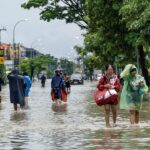Camera footage from orbit shows a volcanic explosion pouring smoke and ash, causing airline delays.
Since 2005, Popocatépetl, Mexico’s most active volcano, has erupted continually in fits and spells.
With over 1,000 thousand minutes of earthquakes every day and massive ash plumes erupting from the summit, last week was a hectic time for the volcano.
Several villages surrounding the volcano reported seeing ash fall from the sky, and local news said that a cloud of ash forced the Puebla International Airport to stop flights on Friday morning.
Because volcanic ash includes microscopic silica particles that can irritate the lungs and airways, inhaling it can cause major respiratory problems, especially for people with health disorders. Furthermore, the eyes, nose, throat, and lungs might get irritated by SO2 emitted by volcanoes.
According to David Kitchen, an associate professor of geology at the University of Richmond in Virginia, “the gases and particles released by volcanic eruptions and lava flows can severely degrade air quality, posing health risks,” Newsweek said.
The Landsat 8 satellite’s OLI (Operational Land Imager) captured these emissions on Friday. The Centro Nacional de Prevención de Desastres (CENAPRED) in Mexico said that day that monitoring systems had found “a continuous emission of water vapour, volcanic gases, and ash.”
About 30 million people reside within 45 miles of Popocatépetl, located in Central Mexico, roughly 45 miles southeast of Mexico City. With a height of around 17,800 feet, it is Mexico’s second-highest summit, behind Pico de Orizaba.
After 50 years of repose, the stratovolcano Popocatépetl erupted in 1994 and has been erupting intermittently ever since, with a noticeable increase in activity since 2005.
On a three-colour alert scale, the Popocatépetl “Volcanic Alert Traffic Light” has been at “Yellow Phase 2″—the middle level—for the whole week and will continue to be so as of October 28.
During this period, “minor to moderate-sized explosions (…)”, “light to moderate ash rains in surrounding towns and some more distant cities (…)”, “ejection of incandescent fragments,” and the “possibility of pyroclastic flows that do not reach populations” are to be anticipated.
“As has been observed recently, eruptions can send incandescent pieces; therefore, do not attempt to ascend the volcano. It is unsafe to be inside the 12-kilometre exclusion radius from the crater. In a translated report, CENAPRED cautioned against going to the bottom of the ravines during periods of heavy rain because of the risk of mud and debris floods.
While SO2 combines with water vapour to generate sulfuric acid, which contributes to acid rain, which harms flora, soils, and water bodies, volcanic ash may bury crops, harm cattle health, taint soil, and poison water sources.
It was discovered that some of this volcanic ash had even made its way hundreds of kilometers northeast, where it was found close to Sarasota, Florida.















